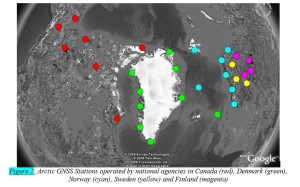| Positioning | |
Challenges for Positioning and Navigation in the Arctic
The paper focuses on the limitations of GNSS in the Arctic, followed by some potential solutions and suggestions for further research |
|
 |
|
|||||
 |
|
|||||
The Arctic ice is receding at a faster pace than expected a few years ago, and is quickly opening for increased human activities beyond the Arctic Circle (66.56° N). This drives a growing demand for navigation in the Arctic area, which is mainly composed of marine expanses and the land masses of Norway, Iceland, Greenland (Denmark), Northern Canada, Alaska (USA), and the Northern parts of Russia.
Marine navigation is expected to increase as both the North-West and North-East passages from the North Atlantic to the West coast of the Americas and to Asia respectively become ice free larger parts of the year. Tourism activity is also expected to expand, with more cruise ships visiting the area as well as a growing use of the sea routes for general transportation of goods and people to and from the cities and settlements in the area. Fishing and hydrographic survey vessels will investigate the new and partly uncharted areas left open by the ice retreat.
Also, as a consequence of the withdrawing ice, the oil and gas sector has an increasing interest in the Arctic, as large and so far mostly un-explored resources are known to be present in the area. The growing activities of the off-shore industry will not only raise the demand for marine transportation, but also traffic with helicopters and small airplanes is expected to rise as more people and material need to be transported between airports, treatment plants on land, and off-shore installations.
Unfortunately, several adverse factors impede safe and accurate positioning in the Arctic. In particular, GNSS-based positioning and navigation face a number of limitations that cannot be easily overcome. This includes the ionospheric effects on satellite signals which in the Arctic are highly affected by an increased electron precipitation causes higher ionospheric variability reducing GNSS performance.
Satellite communications and satellite based augmentation systems for GNSS (SBAS) are also significantly affected by a reduced performance in the Arctic, because the geostationary satellites are visible at very low elevation angles, and in the most Northern parts of the area, the reception of signals from geostationary satellites is not possible at all. This means that positioning and navigation using satellite based augmentation such as the European EGNOS and the American WAAS is generally not feasible in the Arctic. The European Space Agency is aware of this and has just launched an Arctic Testbed project with the purpose of testing measures for improved GNSS navigation in the arctic.
At present, ground based augmentation systems such as the IALA DGPS beacons are not a solution because of the very poor and in most places missing infrastructure of these systems.
Other factors causing reduced safety in the area are the rough weather, the drifting sea ice and ice bergs, the remoteness of the area, poor maps and charts, lower accuracy of magnetic and gyro- compasses etc. All of these problems make positioning and navigation in the area difficult.
This paper aims at raising the awareness about these issues and foster thoughts on finding ways round them. We will focus the discussion on the limitations of GNSS in the Arctic, followed by some potential solutions and suggestions for further research.
Challenges for GNSS in the Arctic
For GNSS, presently GPS and Glonass but in the future also for Galileo, the performance in the Arctic region is reduced compared to the performance obtained by users at mid latitudes. The reasons are mainly the satellite-receiver geometry and the ionospheric effects on the satellite signals, but also users do not have the benefits of satellite based augmentation systems (SBAS) at a larger scale. These three effects are discussed in the following:
Infrastructure for SBAS
For the SBAS systems GPS correction data is transmitted to navigation users via geostationary satellites (GEO). These satellites are located in the geostationary orbit at the Equator and the satellites are thus visible very low on the horizon at high latitudes. SBAS data reception is therefore often noisy and unreliable, and north of 81º N the satellites are not visible at all.
In cases when GEO signals are received at high latitudes the performance of SBAS is reduced compared to lower latitudes. The main reasons for this are the limitations in the ionosphere modeling which is discussed below, but also the large distances between reference stations in the remote Arctic region. After two new EGNOS reference stations (RIMS stations) were established at high latitudes in Norway in 2008, an improvement in EGNOS availability of almost 30 percentage points per day was found for parts of the Norwegian Sea (Jensen et al., 2009). This indicates how the density of the ground based GNSS stations directly affects SBAS performance.
Also, satellite based communications suffer by the same limitations caused by ionospheric activity as satellite based positioning and navigation. In situations with increased ionospheric activity where ionospheric SBAS corrections really are needed for the EGNOS or WAAS user, the transmission of corrections might be disrupted by ionospheric perturbations.
GNSS satellite geometry
For GPS satellites the inclination angle is 55º and for Galileo the planned inclination angle is 56º. This means in practice that no satellites signals are received in the zenith direction north of the corresponding latitudes (i.e. north of 55º and 56º N). If the GNSS receiver is located further north, the elevation angles of the satellites is reduced as the latitude increases.
This can be illustrated by skyplots showing the 24-hour satellite tracks for a given position. Figure 1 provides a skyplot of the GPS satellites for Copenhagen in Denmark at 56° N and for Longyearbyen on Svalbard (Norway) at 78° N. The color coding in the plots indicate the tracks of different GPS satellites.
The consequence of this is better horizontal satellite geometry, but worse vertical satellite geometry compared to the situation at mid and low latitudes. In other words, the HDOP is better and the VDOP is worse for high latitudes. This does directly affect the accuracy of the height in a position solution. But also the horizontal position accuracy is in many cases reduced because there is a higher noise level in the observations, caused by the large number of more noisy low elevation satellite signals. The low elevation of the satellites further worsens the ionospheric effect.
For Glonass the inclination angle is 65º and this does provide slightly better conditions for use of this GNSS at high latitudes.
Ionospheric effect on satellites signals
The ionospheric effect is mainly driven by the solar activity and thus follows the 11-year solar cycle with a currently rising activity and an expected high during 2013-2014.
In the Arctic the ionosphere is further characterized by an enhanced electron precipitation causing higher ionospheric variability and large gradients of TEC. The aurora is a visible illustration of the enhanced electron precipitation.
An example of the ionospheric variability is provided by El-Arini et al. (2009) with GPS data from Thule in Northern Greenland. Results show TEC varying with more than double the background values in less than 10 – 15 minutes, as well as very rapid short term variations in TEC.
Another example is provided by Jensen et al. (2008) with GPS data from Norway and the ionospheric I95 index, which indicates the level of ionospheric variability by estimation of gradients. Here the I95 index is up to five times larger for GPS data collected around 70º N than for data collected at around 60º N during the same epochs in time.
In the positioning algorithms of GNSS navigation receivers the ionospheric effect is normally handled by ionospheric models. But these models are generally insufficient to compensate for the ionospheric effect in the presence of large TEC gradients (Coster et al., 2003).
This is often the case in the Arctic and the consequences for GNSS users with navigation grade receivers is a poor positioning performance with very large errors in the position solution.
For high accuracy positioning and navigation the use of ionospheric models is combined with the ionosphere free linear combinations of observations from the GNSS frequencies in order to minimize the ionospheric effect to a level where carrier phase ambiguity resolution is possible. Higher order ionospheric effects are, however, not handled by the linear combinations.
Second and third order residual errors of 10 cm or more will thus be present in the observations (Morton et al, 2009). In case of large TEC gradients it is difficult, sometimes impossible, to successfully resolve the ambiguities because of the large residual ionospheric effects.
Another effect of the ionosphere is scintillation. This is caused by small irregularities in TEC which induce changes in signal phase or amplitude. Scintillation events in the Arctic are generally correlated with auroral activity, large TEC gradients, and geomagnetic storms. Scintillation causes GNSS receivers to loose lock on the satellite signals, limiting positioning and navigation capabilities.
Scintillation events in the Arctic have been characterized e.g. by Skone et al. (2008). They found that in cases where GNSS receivers were affected by scintillation in Northern Canada, electron density irregularities present in the ionosphere were spanning a very large range in altitude, from about 100 to 300 km above the ground based GNSS receivers.
Many of the present GNSS users in the Arctic region, especially in Norway and Greenland, operate in the area of the auroral oval or just south of the auroral oval, and here GNSS performance is also affected by the ionospheric trough (also called the ‘main trough’), a region with depleted ionization located just south of the auroral oval (Hunsucker and Hargreaves, 2003).
GNSS signals passing through the trough are affected by the TEC gradients and users in this area are thus further exposed to scintillation as well as to limitations in the ionosphere models and problems with ambiguity resolution.
Suggestions for solutions
Considering the growing activity in the Arctic, the problems with the present navigational means, and the consequences of accidents it seems very important to focus more R&D resources on improving navigation systems in the Arctic.
One of the potential solutions already on its way is multiple frequencies for GPS and Galileo. More frequencies provide more data in the positioning algorithms, and this does in general improve performance. Also more frequencies provide better means for handling the ionospheric effect, because more combinations of observations of the various frequencies can be generated.
However, higher order effects of the ionosphere are difficult to remove even with more frequencies, and the problems with the low elevation satellites and the scintillation effects are not solved by transmitting on more frequencies in the L-band.
Another obvious solution which is already available to some extent is the use of inertial navigation systems (INS) combined with GNSS. The inertial sensors are integrated with GNSS to bridge the navigation solution during scintillation gaps and help mitigate the effect of large unexpected TEC gradients. At high latitude, INS suffers from poorer heading accuracy, because the earth rotation rate vector measured by conventional gyroscopes is almost vertical.
This makes the users more dependent on GNSS for heading measurements. Given the short duration of scintillation events, though, this would not be an issue for most of them. INS may also support autonomous integrity against fast variations of TEC.
In order to obtain solutions which will last longer and provide more reliability to Arctic positioning and navigation, new and improved methods for ionospheric time/spatial variability models must be developed.
Basically, more knowledge of the ionospheric activity in the Arctic is needed by the scientific community in order to develop better and more robust models for this region. Figure 2 illustrates the location of 30 high grade geodetic type GNSS stations in the Arctic operated by National agencies. It is recommended to acquire data from a denser observation network, both in order to monitor and better map the ionospheric activity in the Arctic, but also to better feed real time ionosphere models and predictions for improved performance. Benefitting from the seasonal feature of the activity in the Arctic, most navigation needs appearing during summer, it may also be considered to use temporary and expandable (e.g. air-dropped) observation stations, or data collected from mobile stations (vessels).
Figure 2. Arctic GNSS Stations operated by national agencies in Canada (red), Denmark (green), Norway (cyan), Sweden (yellow) and Finland (magenta)
One aspect is the ability to monitor the propagation of traveling ionosphere disturbances which will to some extent enable predictions of TEC gradients with a denser network of GNSS stations. This could form the basis for a GNSS based ionospheric warning system in the Arctic.
Using a combination of various types of observations of the ionosphere for instance GNSS data, magnetometer data, and radar can also lead to improved ionosphere models by the use of advanced data fusion methods.
For distribution of GNSS augmentation data in the Arctic the use of the MEO constellation of navigation satellites (i.e. the GNSS satellites themselves) must be investigated, for instance the planned MRS channel of Galileo. This does indeed seem like the best long term solution, but with the present Galileo design, there is a limited capacity of the MRS channel and the bandwidth is too narrow for broadcasting enhanced SBAS corrections.
Long endurance UAVs (unmanned aerial vehicles) could be another solution. These could be positioned over the region of interest, and data could be communicated and relayed from the most remote regions into regions with adequate communication infrastructure. The advantage of the UAVs is that these can be moved and placed where the need for reliable navigation is highest. Alternatively, aerostatic stations such as e.g. the NASA’s Ultra Long Duration Balloon used in Antarctica might be considered for periods up to a few months. Also the use of low frequency (LF) radio waves should be investigated. The Arctic region is covered by LF radio which is presently used for instance for communication with vessels in remote areas. Use of LF channels for dissemination of GNSS augmentation data does however also require further investigations on data structures, messages types etc.
A consequence of increased human activities in the Arctic is the foreseeable demand for improved communication capabilities. Therefore a dedicated constellation of satellites might be considered, using highly elliptical orbits (e.g. Molniya or Tundra), which would take care of GNSS augmentation data broadcast as well as many other communication needs. It is noteworthy that highly elliptical orbits have been selected by Japan for QZSS, and such satellites would also be much appreciated from GNSS users in urban environments at moderate northern latitudes, where geostationary satellites signals are too often masked.
Conclusion
If an accident does happen in the Arctic the consequences can be serious. The remoteness, the large distances, and the rough weather cause difficulties for search and rescue (SAR) operations as the nearest airstrip is often very far away. Also the Arctic environment is vulnerable and very slow in regeneration after for instance an oil spill, so an accident could initiate an environmental disaster.
There is a need for improved systems for positioning and navigation in the Arctic soon. Most professionals will not wait to roam the Arctic area, and the authors of this paper therefore encourage more focus on research and development for improved navigation systems in the Arctic.
Acknowledgements
The authors would like to thank Dr. Per Knudsen, Danish National Space Institute, for providing the map in Figure 2.
References
Coster, A., Foster, J., Erickson, P. (2003). Monitoring the Ionosphere with GPS. GPS World. May 2003.
El-Arini, M.B., Secan, J., Klobuchar, J.A., Doherty, P.H., Bishop, G., Groves, K. (2009). Ionospheric effects on GPS signals in the Arctic region using early GPS data from Thule, Greenland. Radio Science. Vol. 44, 2009.
Hunsucker, R.D. and Hargreaves, J.K. (2003). The High-Latitude Ionosphere and its Effects on Radio Propagation. Cambridge University Press. 2003.
Jensen, A.B.O., Grinde, G., Hanssen, R.I. (2008). System for Performance Monitoring with Respect to Ionospheric Activity at High Latitudes. Proceedings of the European Navigation Conference, Toulouse, France. ENC – 2008.
Jensen, A.B.O., Hanssen, R.I., Mikkelsen, A., de Mateo, J. (2009). EGNOS Performance in Northern Latitudes. Proceedings of the 13th IAIN World Congress, Stockholm, 27-30 October 2009. Published by the Nordic Institute of Navigation.
Morton, Y.T., van Graas, F., Zhou, Q., Herdtner, J. (2009). Assessment of the Higher Order Ionosphere Error on Position Solutions. Navigation, Journal of the Institute of Navigation, Vol 56, no. 3, Fall 2009
Skone, S., Man, F., Ghafoori, F., Tiwari, R. (2008). Investigation of Scintillation Characteristics for
High Latitude Phenomena. Proceedings of the 21st International Technical Meeting of the Satellite Division of the Institute of Navigation – ION GNSS 2008.
Navigation Engineering Consultant
My Coordinates |
EDITORIAL |
|
His Coordinates |
Charles Branch, Subba Rao |
|
News |
INDUSTRY | GPS | GALILEO UPDATE | LBS | GIS | REMOTE SENSING |














 (3 votes, average: 4.67 out of 5)
(3 votes, average: 4.67 out of 5)



Leave your response!